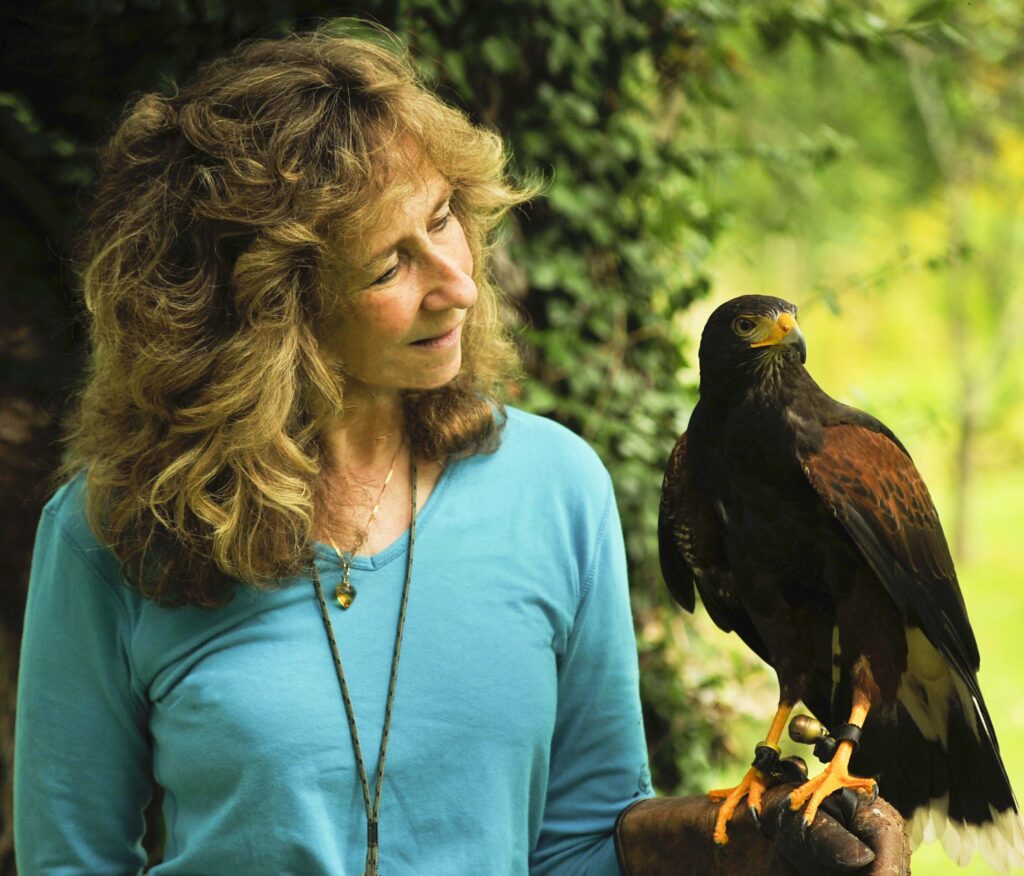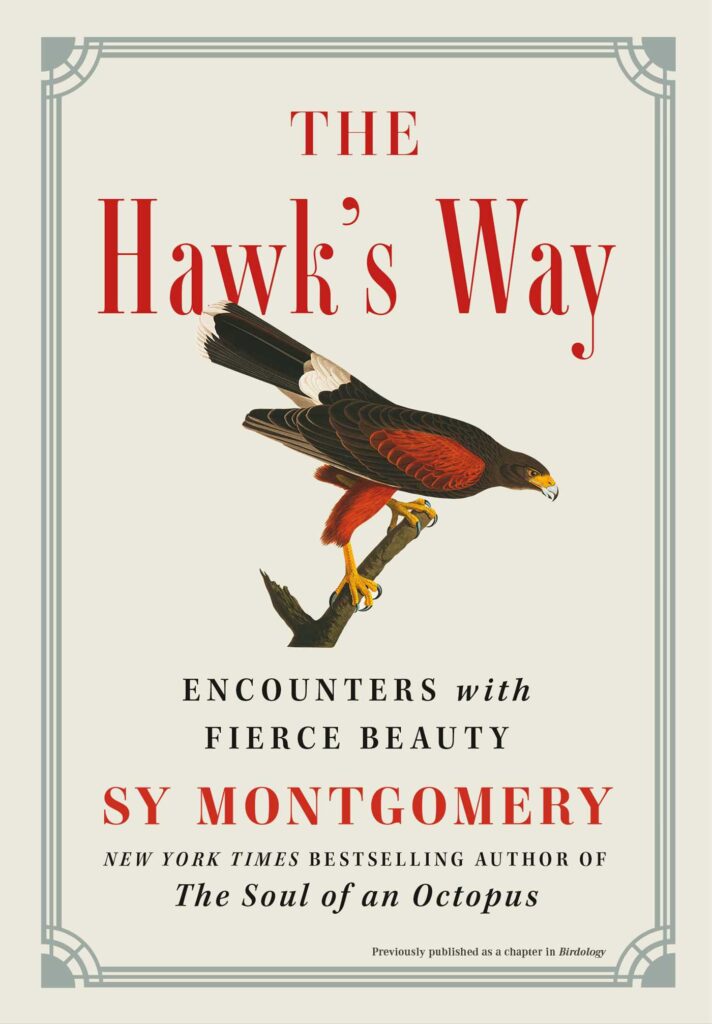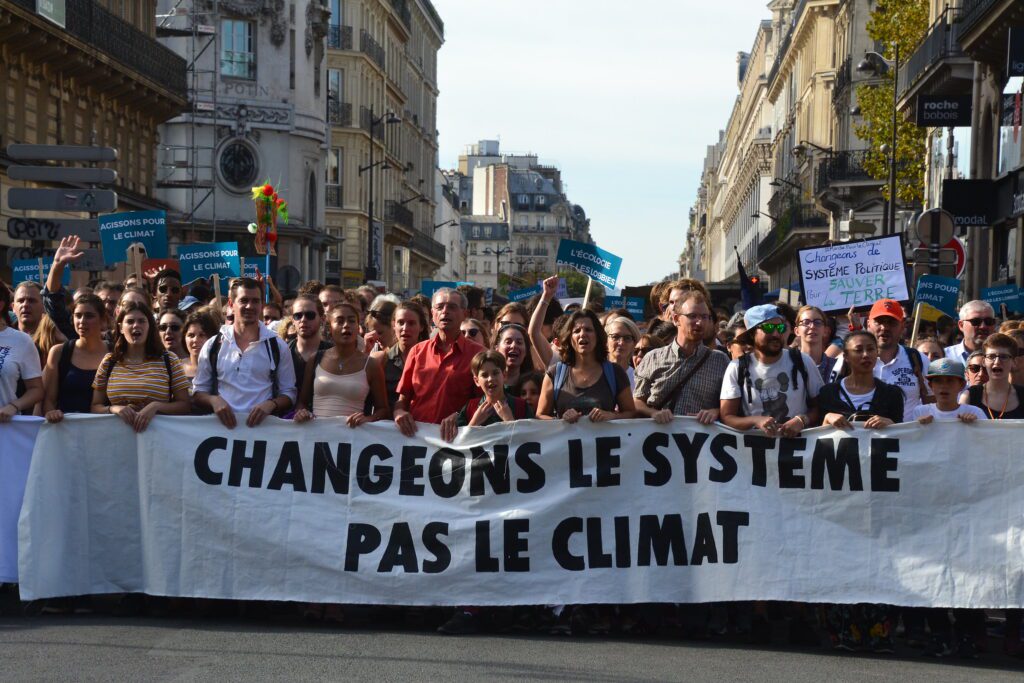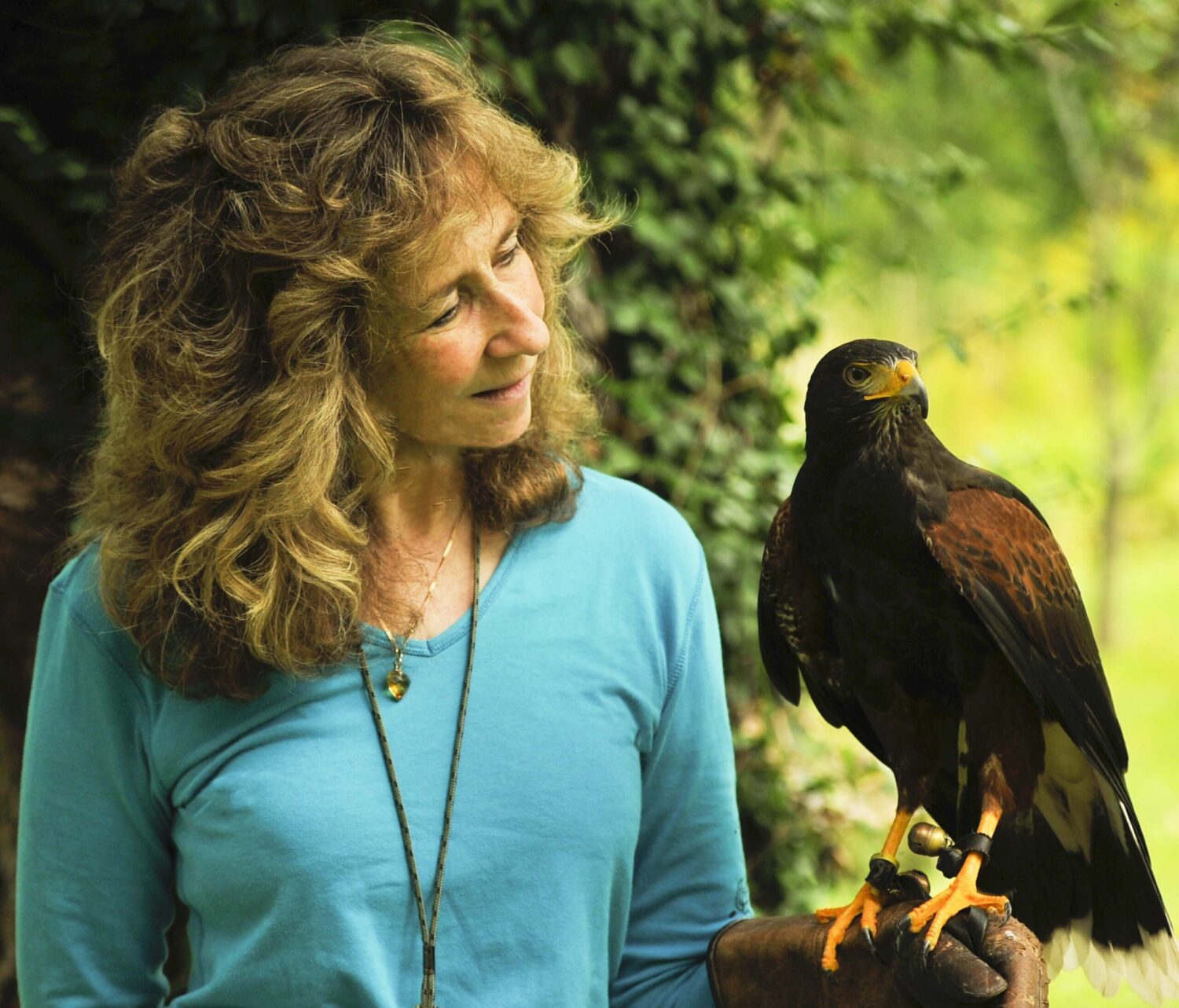


Sy Montgomery built a relationship with a hawk and learned about nature, life and love.
By Sy Montgomery, Independent Media Institute
6 min read
This excerpt is from The Hawk’s Way by Sy Montgomery. An earlier version of this material appeared as a chapter in Sy Montgomery’s book Birdology (2010). “Birds Are Fierce” from Birdology copyright © 2010 by Sy Montgomery. Reprinted by permission of Atria Books, a Division of Simon & Schuster, Inc. This excerpt was produced for the web by Earth | Food | Life (a project of the Independent Media Institute) and Atria Books.
One of the defining characteristics of birds is the crucial role and astonishing acuity of their vision. Flight, after all, demands excellent eyesight. For birds that hunt on the wing, the eyes are developed to an extraordinary degree: an eagle riding a thermal at 1,000 feet can spot its prey across a distance of nearly 3 square miles. In this regard, raptors are remarkable birds. They have developed the avian sense of sight to perfection. The vision of some raptor birds, like eagles and hawks, is the sharpest of all living creatures.
All birds’ eyes are huge in proportion to their bodies. A human being’s eyes take up only 2 percent of the face; a European starling’s account for 15. A great horned owl’s eyes are so enormous relative to its head that if human eyes were comparable, they would be the size of oranges. Birds’ eyes are so important to them that, like various reptiles, sharks, and amphibians, they have a transparent or translucent third eyelid, the nictitating membrane, to protect and moisten the eyes while retaining visibility. Vision literally sculpts birds’ every movement: one reason birds seem to move in such a jerky manner, as cassowary expert Andy Mack explained to me, is that the bird is actually keeping its head remarkably still, thanks to an extremely supple neck, while the rest of its body is in motion, in order to allow it to focus on what it sees in exceptional detail.
In birds of prey, the eyes weigh more than the brain. The two eyes are twice as large as the brain itself. They need to be huge. They are packed with receptors, some types of which humans don’t have at all. Raptors have not merely two (as we do) but six types of photoreceptors in each eye. Because of this, birds are thought to be able to experience colors that humans cannot even describe. Their retinas, unlike ours, contain few blood vessels. Instead, a thin, folded tissue called pecten, unique to birds, brings blood and nutrients to the eye without casting shadows or scattering light in the eye as blood vessels do.
Most birds, like most mammals, have a single area within the eye of perfect vision, called the fovea, where cone cells, which detect sharp contrast and detail, are most concentrated. A raptor’s eye has two foveae. One is for lateral vision, the other for forward vision. A human eye has 200,000 cones per square millimeter in the fovea. Sparrows have twice that. Raptors have about a million.
Raptors see in such fine detail that humans need microscopes to begin to imagine it. They also have a wider field of vision than we do, thanks to the second fovea, as well as better distance perception than other birds. Most birds’ eyes lie at the sides of the head so that when they look at something, they use one eye at a time. With forward-facing eyes, raptors have binocular vision like ours, but better. Fields of view of the left and right eye overlap, allowing the brain to compare the slightly different images from each eye and instantly calculate distance.
And there is something else about a raptor’s vision, something more difficult to describe. “These birds don’t think the way we think,” master falconer Nancy Cowan tells us. “They don’t learn the same way we do.” Because of our differing brain circuitry, birds capture at a glance what it might take a human many seconds to apprehend. For all birds, but especially these, seeing is not merely believing; seeing is knowing. Seeing is being. That is what I see in the monstrous, devouring eyes of Jazz, a four-year-old female Harris hawk: the windows to a mind completely different from my own.
“It’s instinctive,” says Cowan, who runs the New Hampshire School of Falconry. “It’s not spiritual. A falcon is at once the stupidest thing you’ll ever deal with—and the most instinctively developed thing you’ll ever deal with.”
Instinct gets short shrift among most humans. We value thinking instead and dismiss instinct as the machinery of an automaton. But instinct is what lets us love life’s juicy essence: instinct is why we enjoy food and drink and sex.
Thinking can get in the way of living. Too often we see through our brains, not through our eyes. This is such a common human failing that we joke about the absentminded professor or the artist so focused on an imagined canvas that they walk into a tree.
But Jazz won’t smack into a tree. We are out in the field across the street now, and Cowan unclips the jesses that keep Jazz tethered to my glove. “Let her fly,” says Cowan. I give Jazz a brief toss from my glove, and she sails into a pine. She looks down at us. Now I am worthy of Jazz’s interest. She knows something is about to happen. For the first time, I am bathed in her sight. It’s a baptism, and feels momentous, transforming. “Now call her in,” says Cowan. She takes a piece of cut-up partridge out of a baggie in her pocket and places it between the thumb and forefinger of my glove. “Jazz!” she calls. I extend my left arm and look up. A huge, powerful bird flies toward me.
Not everyone would like this, I realize. An exceptionally brave biologist with whom I have worked in Southeast Asia, hiking in search of bears among forests littered with unexploded ordnance, confesses he would be scared. It’s a genetically programmed human reaction. Birds like this once hunted and killed our ancestors. A famous fossil hominid, the so-called Taung child, discovered in South Africa in 1924 and described by Raymond Dart, bears the marks of this predation. When I was in college, we were taught that this long-dead australopithecine child must have been killed by an ancient leopard. Now, from careful reexamination of the skull, we know that the death blow dealt to the brain came from the talons of an ancient relative of the crowned hawk eagle—a raptor that still hunts large monkeys in the same manner today. Our kind has rightly viewed birds like Jazz with caution for more than 2 million years. No wonder so many people flinch in their presence.
But as Jazz’s talons reach for my glove, my heart sings.
Sy Montgomery is a naturalist, documentary scriptwriter and author of 31 books of nonfiction for adults and children, including Hummingbirds’ Gift, the National Book Award finalist The Soul of an Octopus, and the New York Times bestselling memoir The Good Good Pig. She is the recipient of lifetime achievement awards from the Humane Society and the New England Booksellers Association.
Take action…
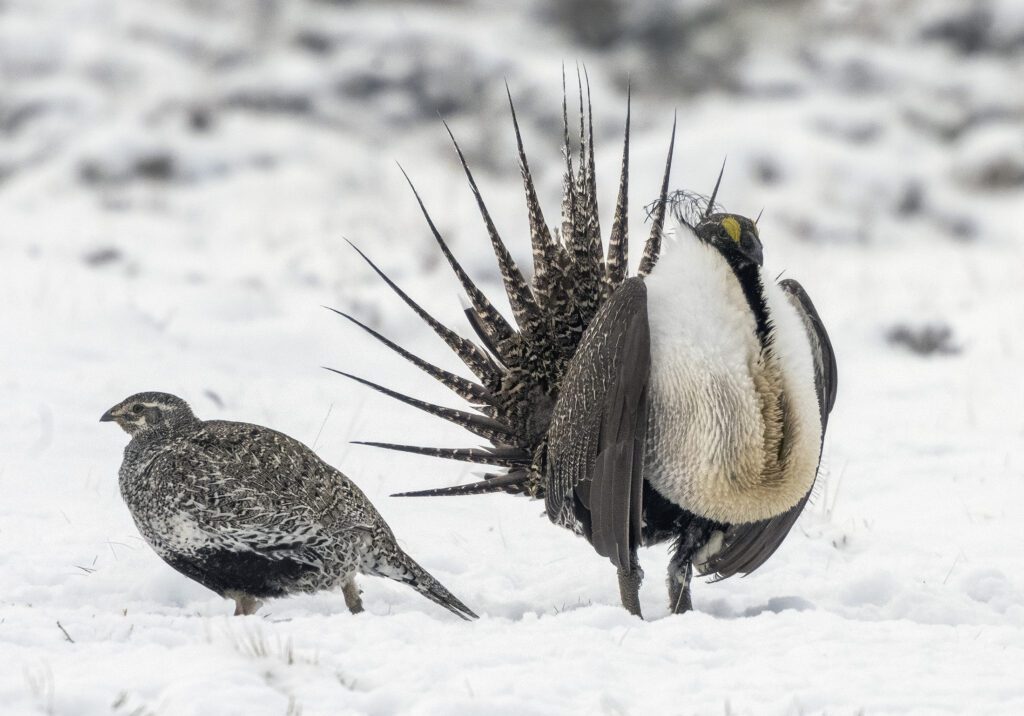
“Oil and gas development is a major threat to birds, and in particular to greater sage-grouse populations, which continue to decline,” said Steve Holmer, vice president of policy at American Bird Conservancy, a nonprofit, in response to the April 15 announcement by the Biden administration that the federal government will resume selling oil and gas leases on public lands.
“Past impacts from drilling in priority sagebrush habitats have yet to be addressed, and given recent climate studies outlining dire consequences for inaction, we are opposed to more fossil fuel development on public lands,” Holmer writes. “It is time to prioritize renewables including rooftop solar and wind power—so long as wind energy facilities avoid high-risk areas for birds and are properly designed to minimize impacts.”
Act now to restore protections for birds by urging your representative and senators to co-sponsor the Protect America’s Wildlife and Fish in Need of Conservation Act (S.2491/H.R.4348) and to oppose any legislation or federal rule that would weaken ESA protections or target individual species for exemption.
Cause for concern…
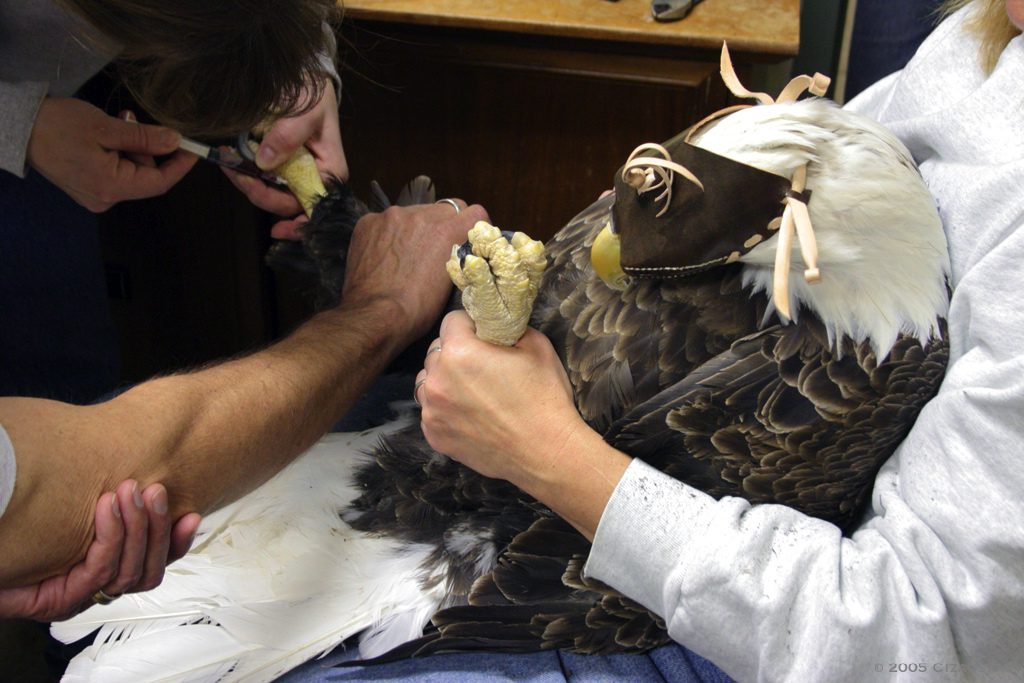
“Bird flu is killing an alarming number of bald eagles and other wild birds, with many sick birds arriving at rehabilitation centers unsteady on their talons and unable to fly.
“‘It’s quite a sight to see an eagle with a six-foot wingspan having uncontrollable seizures because of highly pathogenic avian influenza,’ said Victoria Hall, executive director of the University of Minnesota’s Raptor Center. ‘At that point, they’re so far into the disease [there are] no treatment options left.’
“The latest outbreak of the highly contagious virus has led to the culling of about 37 million chickens and turkeys in U.S. farms since February, and the U.S. Department of Agriculture has confirmed 956 cases of bird flu in wild birds, including at least 54 bald eagles. But the actual number is likely significantly higher because not every wild bird that dies is tested and the federal tally doesn’t include cases recorded by wildlife rehabilitation centers.”
—Josh Funk, “Bird flu takes unheard-of toll on bald eagles, other birds” (AP News, May 5, 2022)
What our friends are saying…
[Editor’s note: Carter Dillard is the policy director of the Fair Start Movement, author of “Justice as a Fair Start in Life: Understanding the Right to Have Children,” and contributor to Earth | Food | Life (see “Better family planning can improve public health, inequality and the environment” and “Kamala vs. Mitt: Differing Family Planning Viewpoints Prefigure Different Futures for Planetary Health”). Carter recently published an opinion piece on MSN that investigates the failure of the Paris Agreement—and his prescription for fixing it. An excerpt is below.]
“According to the anthropocentric view of our environmental responsibilities, we owe a livable planet to other people, especially to our children. We imagine a “leave no trace” ethic can preserve the category we hold in our minds of a pristine natural habitat to bequeath to posterity. Yet our posterity is part of the problem. The more our population grows, the more we’re imposing destructive human impacts on the natural world, and the more disrupted the climate and environment will get.
“There is staunch resistance to accepting this self-evident fact. But it’s beyond dispute that choosing to have fewer children, and/or to delay starting a family, is key to lowering human climate impacts. It’s also key to rewilding and making room for nature. Family planning policies, for good or ill, will condition the ecological and climate future. Yet we behave as if having as many children as we can is a right and law unto itself. …
“Human reproductive choices and policies will determine not only how much carbon we emit and what climate impacts we’ll have, but how most people will experience those impacts — the resources they will or won’t have access to, how resilient in the face of climate change their communities will or won’t be, whether or not their societies will be democratic and respect rights and the rule of law.”
—Carter Dillard, “The Paris Agreement is failing; we need a new approach” (MSN, April 23, 2022)
Round of applause…
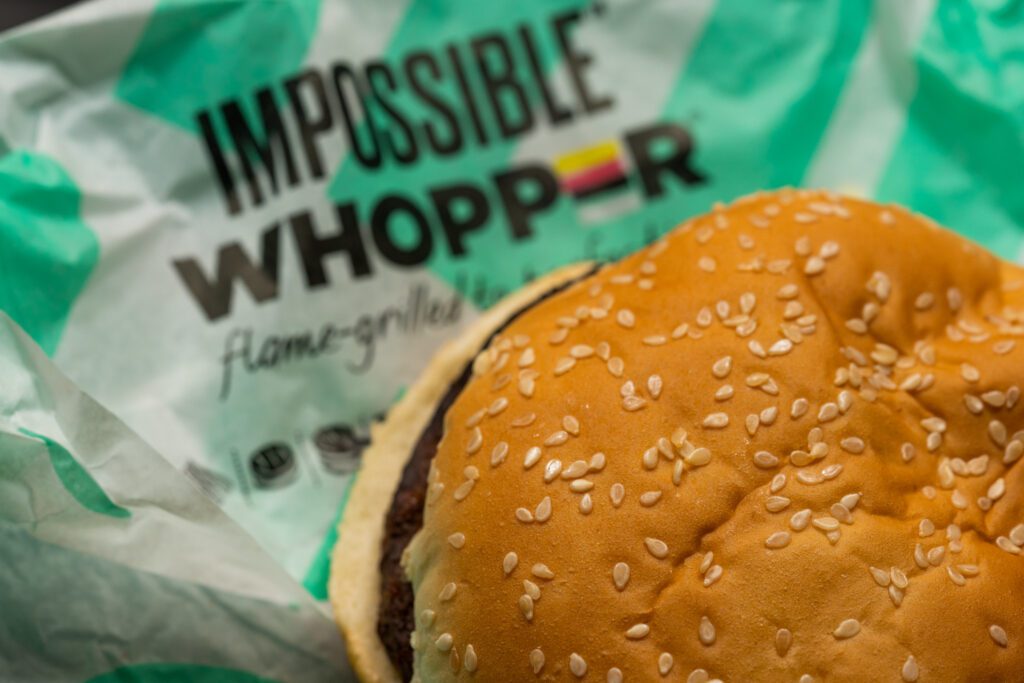
“[T]he fast-food brand that has seemingly had the most success going plant-based is Burger King. The chain was one of the earlier adopters of vegan meat. It launched the Impossible Whopper in 2019 and saw same-store sales jump 6 percent in the quarter that followed. This veggie success inspired ‘The King’ to launch Impossible nuggets last fall, but only in select U.S. cities without plans for a nationwide rollout.
“[T]he chain saw ‘stunning success’ with their most daring foray into veganism to date—a month-long 100 percent vegan menu at one of their high-traffic storefronts in London. The success has spurned Burger King to set a new goal for itself: a 50 percent meat-free menu by 2030.”
—Ashley Uzer, “This major fast-food burger chain is planning to go 50 percent meatless” (Eat This, Not That, May 5, 2022)
ICYMI…
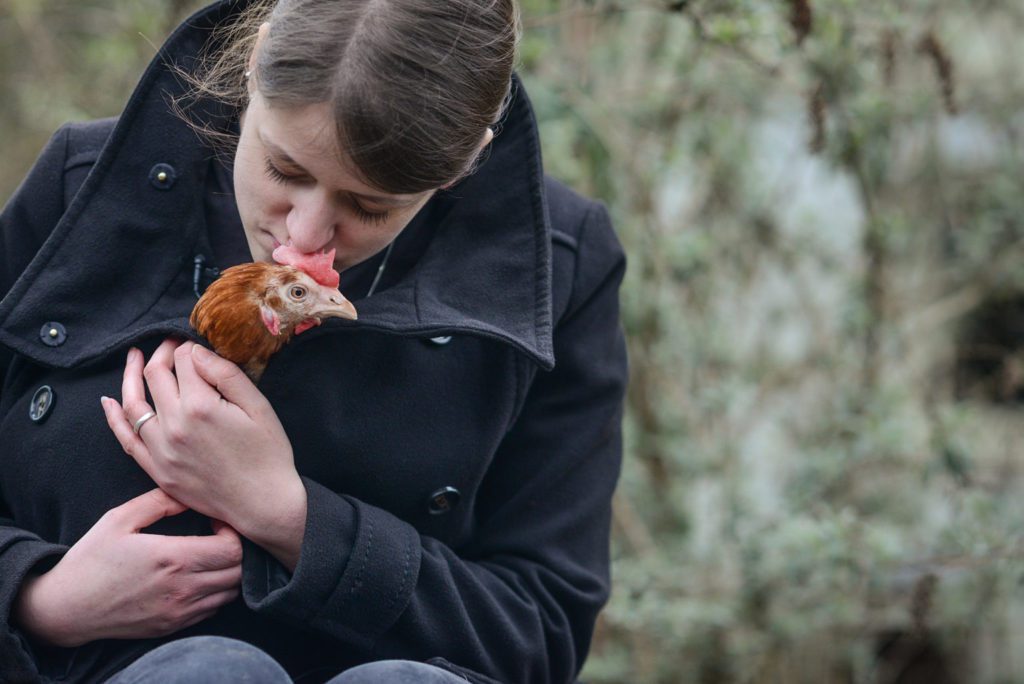
“An annoyed hen will confront a pesky young rooster with her hackles raised and run him off. Although chickens will fight fiercely, and sometimes successfully, with foxes and other predators to protect their families, with humans, however, this kind of bravery usually does not win. A woman employed on a chicken ‘breeder’ farm in Maryland, berated the defenders of chickens for trying to make her lose her job, and threatening her ability to support herself and her daughter. For her, the ‘breeder’ hens were ‘mean’ birds who ‘peck your arm when you are trying to collect the eggs.’ In her defense for her life and her daughter’s life, she failed to see the similarity between her motherly protection of her child and the exploited hen’s courageous effort to protect her own offspring.”
—EFL contributor Karen Davis, “On International Respect for Chickens Day, Try Thinking About Them Differently” (Countercurrents, April 26, 2022)
Parting thought…
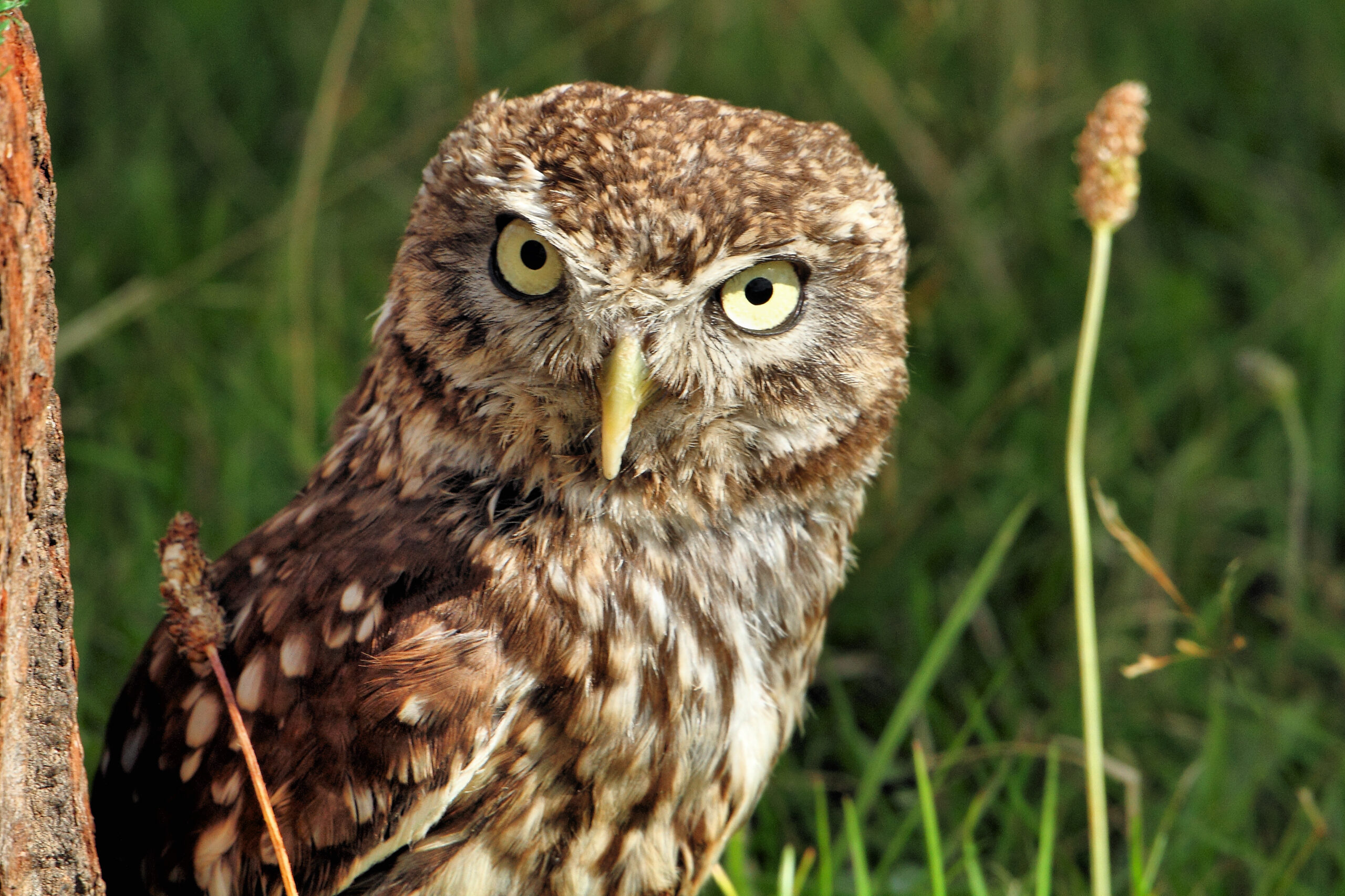
“If all the beasts were gone, men would die from a great loneliness of spirit, for whatever happens to the beasts also happens to the man. All things are connected.” —Chief Seattle
Earth | Food | Life (EFL) explores the critical and often interconnected issues facing the climate/environment, food/agriculture and nature/animal rights, and champions action; specifically, how responsible citizens, voters and consumers can help put society on an ethical path of sustainability that respects the rights of all species who call this planet home. EFL emphasizes the idea that everything is connected, so every decision matters.
Click here to support the work of EFL and the Independent Media Institute.
Questions, comments, suggestions, submissions? Contact EFL editor Reynard Loki at [email protected]. Follow EFL on Twitter @EarthFoodLife.
